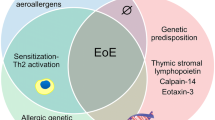Abstract
Background
Eosinophilic esophagitis (EE) is an inflammatory disorder of the esophagus characterized by symptoms such as dysphagia, food sticking and heartburn. Several fluoroscopic findings have been described in EE, but the frequency of these findings is unknown.
Objective
To identify the frequency of imaging findings in pediatric-age patients with eosinophilic esophagitis.
Materials and methods
A retrospective study was performed evaluating all upper GI and esophagram studies performed between 2000 and 2008 in patients up to age 21 with a pathological diagnosis of EE. In order to be included in the study, the upper GI or esophagram had to be performed either before EE was diagnosed or within 30 days of the diagnosis. Two pediatric radiologists evaluated each study for the presence or absence of multiple findings of EE. The radiology reports from the time of the study were then read to establish a concurrent diagnosis of esophageal dysmotility or gastroesophageal reflux. Finally, the hospital electronic medical record was evaluated to obtain demographic and pathology information.
Results
Of the 579 patients with biopsy-proven EE, 107 (18%) were included in the study and underwent a total of 112 upper GI or esophagram examinations. The most common finding on these examinations was a normal esophagus (58/112; 52%) followed by gastroesophageal reflux (21/112; 19%) and irregular contractions (17/112; 15%). Less frequent findings included strictures, dysmotility, mucosal irregularity, esophageal rings and filling defects.
Conclusion
Fluoroscopic studies are not a sensitive method to diagnose EE because nearly half of the studies are normal. Findings that have been described in the setting of EE such as food impaction, a ringed esophagus, a small-caliber esophagus and esophageal stricture do not occur with a high enough frequency to reliably make a diagnosis.






Similar content being viewed by others
References
Noel RJ, Putnam PE, Rothenberg ME (2004) Eosinophilic esophagitis. N Engl J Med 351:940–941
Liacouras CA, Spergel JM, Ruchelli E et al (2005) Eosinophilic esophagitis: a 10-year experience in 381 children. Clin Gastroenterol Hepatol 3:1198–1206
Markowitz JE, Spergel JM, Ruchelli E et al (2003) Elemental diet is an effective treatment for eosinophilic esophagitis in children and adolescents. Am J Gastroenterol 98:777–782
Furuta GT, Liacouras CA, Collins MH, First International Gastrointestinal Eosinophil Research Symposium (FIGERS) Subcommittees (2007) Eosinophilic esophagitis in children and adults: a systematic review and consensus recommendations for diagnosis and treatment. Gastroenterology 33:1342–1363
Putnam PE, Rothenberg ME (2009) Eosinophilic esophagitis: concepts, controversies, and evidence. Curr Gastroenterol Rep 11:220–225
Picus D, Frank PH (1981) Eosinophilic esophagitis. AJR 136:1001–1003
Feczko PJ, Halpert RD, Zonca M (1985) Radiographic abnormalities in eosinophilic esophagitis. Gastrointest Radiol 10:321–324
Vitellas KM, Bennett WF, Bova JG et al (1993) Idiopathic eosinophilic esophagitis. Radiology 186:789–793
Vasilopoulos S, Murphy P, Auerbach A et al (2002) The small-caliber esophagus: an unappreciated cause of dysphagia for solids in patients with eosinophilic esophagitis. Gastrointest Endosc 55:99–106
Zimmerman SL, Levine MS, Rubesin SE et al (2005) Idiopathic eosinophilic esophagitis in adults: the ringed esophagus. Radiology 236:159–165
Tsai CM, Butler J, Cash BD (2007) Pseudodiverticulosis with eosinophilic esophagitis: first reported case. Gastrointest Endosc 66:1223–1224
White SB, Levine MS, Rubesin SE et al (2010) The small-caliber esophagus: radiographic sign of idiopathic eosinophilic esophagitis. Radiology 256:127–134
Binkovitz LA, Lorenz EA, Di Lorenzo C et al (2010) Pediatric eosinophilic esophagitis: radiologic findings with pathologic correlation. Pediatr Radiol 40:714–719
Yan BM, Shaffer EA (2006) Eosinophilic esophagitis: a newly established cause of dysphagia. World J Gastroenterol 12:2328–2334
Sant’Anna AM, Rolland S, Fournet JC et al (2004) Eosinophilic esophagitis in children: symptoms, histology and pH probe results. J Pediatr Gastroenterol Nutr 39:373–377
De Angelis P, Markowitz JE, Torroni F et al (2006) Paediatric eosinophilic oesophagitis: towards early diagnosis and best treatment. Dig Liver Dis 38:245–251
Orenstein SR, Shalaby TM, Di Lorenzo C et al (2000) The spectrum of pediatric eosinophilic esophagitis beyond infancy: a clinical series of 30 children. Am J Gastroenterol 95:1422–1430
Matzinger MA, Daneman A (1983) Esophageal involvement in eosinophilic gastroenteritis. Pediatr Radiol 13:35–38
Marshak RH, Lindner A, Maklansky D et al (1981) Eosinophilic gastroenteritis. JAMA 245:1677–1680
Spechler SJ, Genta RM, Souza RF (2007) Thoughts on the complex relationship between gastroesophageal reflux disease and eosinophilic esophagitis. Am J Gastroenterol 102:1301–1306
Ngo P, Furuta GT, Antonioli DA et al (2006) Eosinophils in the esophagus—peptic or allergic eosinophilic esophagitis? Case series of three patients with esophageal eosinophilia. Am J Gastroenterol 101:1666–1670
Peterson KA, Thomas KL, Hilden K et al (2010) Comparison of esomeprazole to aerosolized, swallowed fluticasone for eosinophilic esophagitis. Dig Dis Sci 55:1313–1319
Locke GR 3rd, Talley NJ, Fett SL et al (1997) Prevalence and clinical spectrum of gastroesophageal reflux: a population-based study in Olmsted County, Minnesota. Gastroenterology 112:1448–1456
Shaheen N, Provenzale D (2003) The epidemiology of gastroesophageal reflux disease. Am J Med Sci 326:264–273
Molina-Infante J, Ferrando-Lamana L, Ripoll C et al (2011) Esophageal eosinophilic infiltration responds to proton pump inhibition in most adults. Clin Gastroenterol Hepatol 9:110–117
Nurko S, Rosen R, Furuta GT (2009) Esophageal dysmotility in children with eosinophilic esophagitis: a study using prolonged esophageal manometry. Am J Gastroenterol 104:3050–3057
Lucendo AJ, Castillo P, Martín-Chávarri S et al (2007) Manometric findings in adult eosinophilic oesophagitis: a study of 12 cases. Eur J Gastroenterol Hepatol 19:417–424
Nurko S, Rosen R (2008) Esophageal dysmotility in patients who have eosinophilic esophagitis. Gastrointest Endosc Clin N Am 18:73–89
Lao J, Bostwick HE, Berezin S et al (2003) Esophageal food impaction in children. Pediatr Emerg Care 19:402–407
Diniz LO, Towbin AJ (2011) Causes of esophageal food bolus impaction in the pediatric population. Dig Dis Sci Sep 23 [Epub ahead of print]
Author information
Authors and Affiliations
Corresponding author
Rights and permissions
About this article
Cite this article
Diniz, L.O., Putnum, P.E. & Towbin, A.J. Fluoroscopic findings in pediatric eosinophilic esophagitis. Pediatr Radiol 42, 721–727 (2012). https://doi.org/10.1007/s00247-011-2329-3
Received:
Revised:
Accepted:
Published:
Issue Date:
DOI: https://doi.org/10.1007/s00247-011-2329-3




